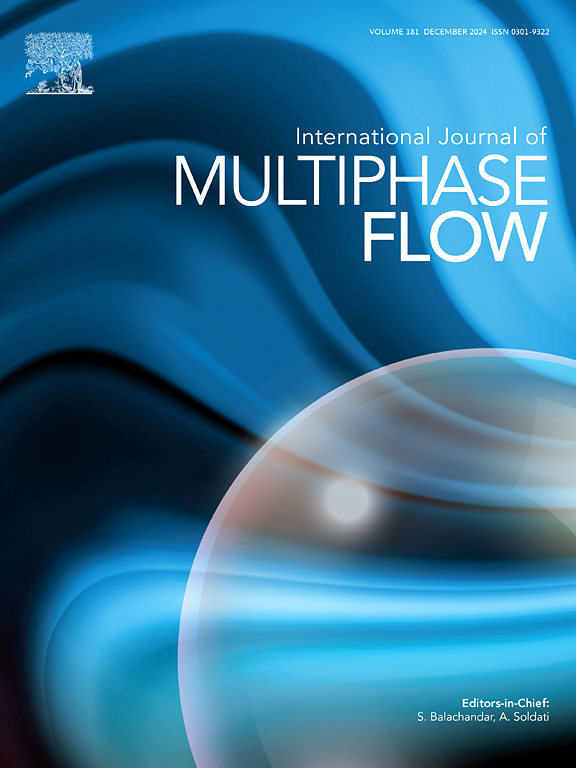利用IBM-thermal ISLBM对变曲率表面微米颗粒沉积的数值研究
IF 3.6
2区 工程技术
Q1 MECHANICS
International Journal of Multiphase Flow
Pub Date : 2025-03-31
DOI:10.1016/j.ijmultiphaseflow.2025.105235
引用次数: 0
摘要
提出了一种统一的算法,用于数值研究湍流中表面曲率对颗粒沉积和换热性能的影响。该方法结合了求解非均匀网格上热流体场的补插补热晶格玻尔兹曼法、处理液缸界面变形的浸入边界法和确定颗粒动力学行为的离散相模型。验证了该模型预测沉积特征的能力。在变曲率表面(lrh = 0.6 ~ 1.4)下,将进口速度从3 ~ 7 m·s-1、Stokes数从0.023 ~ 0.061进行了系统模拟。当lrh由0.6增加到1.4时,沉积层面积和平均努塞尔数分别减少38.66%和17.1%。提高lrh有利于减少沉积,且换热器效率损失不明显。在沉积后期,高动能、低冲击角的沉积颗粒比例增加。随着进口速度的增加,低lrh表面的沉积增强程度更高,换热增强程度更强。提高lrh可以显著缓解中小Stp颗粒的沉积,而对较大Stp颗粒的影响不显著。本文章由计算机程序翻译,如有差异,请以英文原文为准。

A numerical study on micron particle deposition of variable curvature surfaces using IBM-thermal ISLBM
A unified algorithm was developed to numerically investigate the effects of surface curvature on particle deposition and heat exchange performance in turbulent flow. The hybrid approach integrates the interpolation-supplemented thermal lattice Boltzmann method for solving the thermal fluid field on a non-uniform mesh, the immersed boundary method for handling fluid–cylinder interface deformation, and the discrete phase model for determining particle dynamic behavior. The capabilities of the proposed model for predicting deposition characteristics were validated. Systematic simulations were conducted by varying the inlet velocity from 3 to 7 m·s–1 and the Stokes number from 0.023 to 0.061 at variable curvature surfaces (lrh = 0.6–1.4). As lrh increased from 0.6 to 1.4, the deposition layer area and average Nusselt number decreased by 38.66 % and 17.1 %, respectively. Elevating lrh is conducive to reducing deposition with an inconspicuous loss in heat exchanger efficiency. The proportion of deposited particles with high kinetic energy and low impact angle increased during the late deposition period. As the inlet velocity increased, the low lrh surface exhibited higher deposition augmentation and stronger heat transfer enhancement. Elevating lrh can significantly alleviate the deposition of small and medium Stp particles while exerting inconspicuous effects on larger Stp particles.
求助全文
通过发布文献求助,成功后即可免费获取论文全文。
去求助
来源期刊
CiteScore
7.30
自引率
10.50%
发文量
244
审稿时长
4 months
期刊介绍:
The International Journal of Multiphase Flow publishes analytical, numerical and experimental articles of lasting interest. The scope of the journal includes all aspects of mass, momentum and energy exchange phenomena among different phases such as occur in disperse flows, gas–liquid and liquid–liquid flows, flows in porous media, boiling, granular flows and others.
The journal publishes full papers, brief communications and conference announcements.

 求助内容:
求助内容: 应助结果提醒方式:
应助结果提醒方式:


